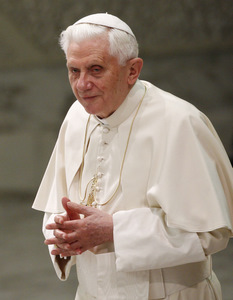Pope: Jews not to blame for crucifixion - Excerpt from Jesus of Nazareth, Part Two
Kris Dmytrenko
Wednesday, March 2, 2011
Who killed Jesus? From the Gospels, we know that he was crucified directly by Roman soldiers. But those who want to attribute blame for his death have drawn in a wider pool of suspects: Judas Iscariot, Pontius Pilate, the Jewish people, and all of humanity. The question of Jewish culpability in "deicide" is particularly charged, given that it has historically been used to justify anti-Semitic violence.
 Pope Benedict has already demonstrated his commitment to Jewish-Christian relations during his visits to synagogues in Cologne, New York City and Rome, and through his trip to Israel in 2009. Now he is presenting the theological case against blaming Jews for the death of Jesus.
In the second volume of “Jesus of Nazareth”, which will be released by Ignatius Press on March 10th, the Pope explains a contentious passage in the Gospel of Matthew. In it, the Jewish crowd shouts, “Let his blood be on us and on our children,” as they demand that Pilate execute Jesus. Yet the Pope insists that the crowd represents all humanity. Further, Jesus’ blood was not “poured out against anyone, it is poured out for many, for all.” Jesus’ blood can never be a curse, “but rather redemption, salvation.”
Posted with permission is an excerpt from the forthcoming book "Jesus of Nazareth, Part Two - Holy Week: From the Entrance into Jerusalem to the Resurrection". In the coming days, the S+L blog will post two more excerpts.
Pope Benedict has already demonstrated his commitment to Jewish-Christian relations during his visits to synagogues in Cologne, New York City and Rome, and through his trip to Israel in 2009. Now he is presenting the theological case against blaming Jews for the death of Jesus.
In the second volume of “Jesus of Nazareth”, which will be released by Ignatius Press on March 10th, the Pope explains a contentious passage in the Gospel of Matthew. In it, the Jewish crowd shouts, “Let his blood be on us and on our children,” as they demand that Pilate execute Jesus. Yet the Pope insists that the crowd represents all humanity. Further, Jesus’ blood was not “poured out against anyone, it is poured out for many, for all.” Jesus’ blood can never be a curse, “but rather redemption, salvation.”
Posted with permission is an excerpt from the forthcoming book "Jesus of Nazareth, Part Two - Holy Week: From the Entrance into Jerusalem to the Resurrection". In the coming days, the S+L blog will post two more excerpts.
 Pope Benedict has already demonstrated his commitment to Jewish-Christian relations during his visits to synagogues in Cologne, New York City and Rome, and through his trip to Israel in 2009. Now he is presenting the theological case against blaming Jews for the death of Jesus.
In the second volume of “Jesus of Nazareth”, which will be released by Ignatius Press on March 10th, the Pope explains a contentious passage in the Gospel of Matthew. In it, the Jewish crowd shouts, “Let his blood be on us and on our children,” as they demand that Pilate execute Jesus. Yet the Pope insists that the crowd represents all humanity. Further, Jesus’ blood was not “poured out against anyone, it is poured out for many, for all.” Jesus’ blood can never be a curse, “but rather redemption, salvation.”
Posted with permission is an excerpt from the forthcoming book "Jesus of Nazareth, Part Two - Holy Week: From the Entrance into Jerusalem to the Resurrection". In the coming days, the S+L blog will post two more excerpts.
Pope Benedict has already demonstrated his commitment to Jewish-Christian relations during his visits to synagogues in Cologne, New York City and Rome, and through his trip to Israel in 2009. Now he is presenting the theological case against blaming Jews for the death of Jesus.
In the second volume of “Jesus of Nazareth”, which will be released by Ignatius Press on March 10th, the Pope explains a contentious passage in the Gospel of Matthew. In it, the Jewish crowd shouts, “Let his blood be on us and on our children,” as they demand that Pilate execute Jesus. Yet the Pope insists that the crowd represents all humanity. Further, Jesus’ blood was not “poured out against anyone, it is poured out for many, for all.” Jesus’ blood can never be a curse, “but rather redemption, salvation.”
Posted with permission is an excerpt from the forthcoming book "Jesus of Nazareth, Part Two - Holy Week: From the Entrance into Jerusalem to the Resurrection". In the coming days, the S+L blog will post two more excerpts.
Jesus’ interrogation before the Sanhedrin had concluded in the way Caiaphas had expected: Jesus was found guilty of blasphemy, for which the penalty was death. But since only the Romans could carry out the death sentence, the case now had to be brought before Pilate and the political dimension of the guilty verdict had to be emphasized. Jesus had declared himself to be the Messiah; hence he had laid claim to the dignity of kingship, albeit in a way peculiarly his own. The claim to Messianic kingship was a political offense, one that had to be punished by Roman justice. With cockcrow, daybreak had arrived. The Roman Governor used to hold court early in the morning. So Jesus is now led by his accusers to the praetorium and is presented to Pilate as a criminal who deserves to die. It is the “day of preparation” for the Passover feast. The lambs are slaughtered in the afternoon for the evening meal. Hence cultic purity must be preserved; so the priestly accusers may not enter the Gentile praetorium, and they negotiate with the Roman Governor outside the building. John, who provides this detail (18:28–29), thereby highlights the contradiction between the scrupulous attitude to regulations for cultic purity and the question of real inner purity: it simply does not occur to Jesus’ accusers that impurity does not come from entering a Gentile house, but rather from the inner disposition of the heart. At the same time the evangelist emphasizes that the Passover meal had not yet taken place and that the slaughter of the lambs was still to come. In all essentials, the four Gospels harmonize with one another in their accounts of the progress of the trial. Only John reports the conversation between Jesus and Pilate, in which the question about Jesus’ kingship, the reason for his death, is explored in depth (18:33–38). The historicity of this tradition is of course contested by exegetes. While Charles H. Dodd and Raymond E. Brown judge it positively, Charles K. Barrett is extremely critical: “John’s additions and alterations do not inspire confidence in his historical reliability” (The Gospel according to Saint John, p. 530). Certainly no one would claim that John set out to provide anything resembling a transcript of the trial. Yet we may assume that he was able to explain with great precision the core question at issue and that he presents us with a true account of the trial. Barrett also says “that John has with keen insight picked out the key of the Passion narrative in the kingship of Jesus, and has made its meaning clearer, perhaps, than any other New Testament writer” (ibid., p. 531). Now we must ask: Who exactly were Jesus’ accusers? Who insisted that he be condemned to death? We must take note of the different answers that the Gospels give to this question. According to John it was simply “the Jews”. But John’s use of this expression does not in any way indicate—as the modern reader might suppose—the people of Israel in general, even less is it “racist” in character. After all, John himself was ethnically a Jew, as were Jesus and all his followers. The entire early Christian community was made up of Jews. In John’s Gospel this word has a precise and clearly defined meaning: he is referring to the Temple aristocracy. So the circle of accusers who instigate Jesus’ death is precisely indicated in the Fourth Gospel and clearly limited: it is the Temple aristocracy—and not without certain exceptions, as the reference to Nicodemus (7:50–52) shows. In Mark’s Gospel, the circle of accusers is broadened in the context of the Passover amnesty (Barabbas or Jesus): the “ochlos” enters the scene and opts for the release of Barabbas. “Ochlos” in the first instance simply means a crowd of people, the “masses”. The word frequently has a pejorative connotation, meaning “mob”. In any event, it does not refer to the Jewish people as such. In the case of the Passover amnesty (which admittedly is not attested in other sources, but even so need not be doubted), the people, as so often with such amnesties, have a right to put forward a proposal, expressed by way of “acclamation”. Popular acclamation in this case has juridical character (cf. Pesch, Markusevangelium II, p. 466). Effectively this “crowd” is made up of the followers of Barabbas who have been mobilized to secure the amnesty for him: as a rebel against Roman power he could naturally count on a good number of supporters. So the Barabbas party, the “crowd”, was conspicuous, while the followers of Jesus remained hidden out of fear; this meant that the vox populi, on which Roman law was built, was represented one-sidedly. In Mark’s account, then, in addition to “the Jews”, that is to say the dominant priestly circle, the ochlos comes into play, the circle of Barabbas’ supporters, but not the Jewish people as such. An extension of Mark’s ochlos, with fateful consequences, is found in Matthew’s account (27:25), which speaks of “all the people” and attributes to them the demand for Jesus’ crucifixion. Matthew is certainly not recounting historical fact here: How could the whole people have been present at this moment to clamor for Jesus’ death? It seems obvious that the historical reality is correctly described in John’s account and in Mark’s. The real group of accusers are the current Temple authorities, joined in the context of the Passover amnesty by the “crowd” of Barabbas’ supporters. Here we may agree with Joachim Gnilka, who argues that Matthew, going beyond historical considerations, is attempting a theological etiology with which to account for the terrible fate of the people of Israel in the Jewish War, when land, city, and Temple were taken from them (cf. Matthäusevangelium II, p. 459). Matthew is thinking here of Jesus’ prophecy concerning the end of the Temple: “O Jerusalem, Jerusalem, killing the prophets and stoning those who are sent to you! How often would I have gathered your children together as a hen gathers her brood under her wings, and you would not! Behold, your house is forsaken . . .” (Mt 23:37–38: cf. Gnilka, Matthäusevangelium, the whole of the section entitled “Gerichtsworte”, II, pp. 295–308). These words—as argued earlier, in the chapter on Jesus’ eschatological discourse—remind us of the inner similarity between the Prophet Jeremiah’s message and that of Jesus. Jeremiah—against the blindness of the then dominant circles—prophesied the destruction of the Temple and Israel’s exile. But he also spoke of a “new covenant”: punishment is not the last word; it leads to healing. In the same way Jesus prophesies the “deserted house” and proceeds to offer the New Covenant “in his blood”: ultimately it is a question of healing, not of destruction and rejection. When in Matthew’s account the “whole people” say: “His blood be on us and on our children” (27:25), the Christian will remember that Jesus’ blood speaks a different language from the blood of Abel (Heb 12:24): it does not cry out for vengeance and punishment; it brings reconciliation. It is not poured out against anyone; it is poured out for many, for all. “All have sinned and fall short of the glory of God . . . God put [Jesus] forward as an expiation by his blood” (Rom 3:23, 25). Just as Caiaphas’ words about the need for Jesus’ death have to be read in an entirely new light from the perspective of faith, the same applies to Matthew’s reference to blood: read in the light of faith, it means that we all stand in need of the purifying power of love which is his blood. These words are not a curse, but rather redemption, salvation. Only when understood in terms of the theology of the Last Supper and the Cross, drawn from the whole of the New Testament, does this verse from Matthew’s Gospel take on its correct meaning.
Related Articles:
Category: Highlight
教宗方濟各昨晚安然入睡,今早起床吃早餐
Wednesday, February 19, 2025
 鹽與光
鹽與光
2025年2月19日上午,聖座新聞室在週三早上在記者會中分享道:「教宗渡過了一個安寧的夜晚,起床後吃了早餐。」此前,聖座新聞室在週二晚上聲明表示教宗感染雙側肺炎。
耶路撒冷教會的人道呼籲:捍衛加沙人民的尊嚴與存在
Tuesday, February 18, 2025
 鹽與光
鹽與光
耶路撒冷的宗主教及各基督宗教領袖:「願仁慈的上主堅固受苦的人,軟化掌權者的心,帶來維護正義、維護人類尊嚴的和平,並保障所有人在屬於他們的土地上的存在。」
教宗方濟各患上雙側肺炎,情況複雜但精神仍然良好
Tuesday, February 18, 2025
 鹽與光
鹽與光
2025年2月18日,星期二下午,聖座新聞室在新聞稿中表示,教宗方濟各患有雙側肺炎,但精神仍然良好。
教宗方濟各入院進行支氣管炎治療
Friday, February 14, 2025
 鹽與光
鹽與光
2025年2月14日,聖座新聞室表示,教宗方濟各今天上午在聖瑪爾大之家進行幾場接見活動後,在羅馬傑梅利醫院住院,為他已感染數日的支氣管炎「進行必要的診斷檢查,並在醫院環境裡繼續接受治療」。
第十六屆世界主教代表會議常務大會《最終文件》【中文】
Friday, February 14, 2025
 鹽與光
鹽與光
2025年2月14日,天主教會臺灣地區主教團發布官方由原文意大利文翻譯成中文的「教宗方濟各第十六屆世界主教代表會議常務大會 以共融、參與及使命來體現共議性的教會 《最終文件》」,歡迎大家下載。
1
2
3
4
5
6
7
8
9
10
11
...
668
>>
SUPPORT LABEL
$50
$100
$150
$250
OTHER AMOUNT
DONATE
Receive our newsletters
Stay Connected
Receive our newsletters
Stay Connected













